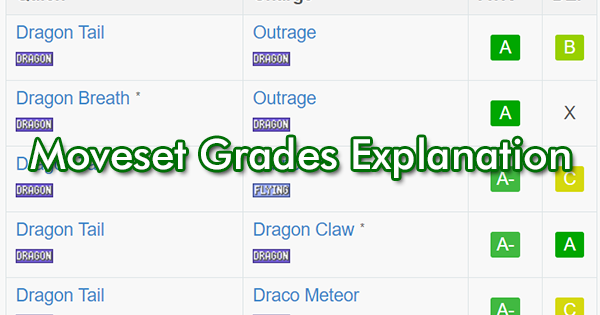Moveset Grades provide a scale for summarizing the quality of a moveset.
- An "A" is the absolute optimal moveset (or tied for it) for a given Pokemon.
- A "B" is a moveset that is suboptimal, but in certain circumstances does have the potential to do just as well as "A" movesets.
- A "C" moveset has niche uses, but ultimately under-performs when compared to others.
- A "D" moveset will not fulfill a Pokemon's potential, and generally won't have much use. It would be wise to use TMs if you have a moveset with this grade.
- An "F" moveset is just about as bad of a moveset as you could imagine on that Pokemon. It's strongly recommended to use TMs if you have a moveset with this grade.
- A "-" in front of a grade means that this moveset performs only slightly worse than other movesets of that grade.
- An "x" moveset is considered unviable and/or thoroughly outclassed by other movesets that fill the same niche. These are the movesets to avoid.
Because these grades are relative to the Pokemon, a good Pokemon's "F" moveset could be better than a bad Pokemon's "A" moveset.
Methodology Overview
You can read in great deal the considerations employed in developing these ratings, but the short story is that the methods used to develop our Attackers and Defenders Tier Lists are extended to these grades.
We use a combination of gym simulation results (which will feature energy usage and energy efficiency), metagame factors (attacker and defender popularity, etc) as well as to a lesser extent, efficiency with dodging factored when particularly relevant.
Attacking Movesets Methodology
Each Pokemon has a particular role that they best excel at, so most, if not all Pokemon can be useful attackers. Attacking movesets grades are aimed at making Pokemon excel the most in their particular role, as well as improve their viability in a handful of other feasible match-ups.
Having two attacks of the same type is generally an advantage, as you can more directly abuse the gym defender's type disadvantage that you're exploiting.
Each player has a different playstyle, but we assume most players only dodge charge moves while attacking. Generally, moves with a shorter cool down are better for players who dodge, while moves with higher damage output but a longer dodge window are better for players who don't dodge. Both circumstances are considered in this iteration of the ratings.
Defending Movesets Methodology
Most Pokemon are not meant to be defenders (e.g., Alakazam, Tangela, etc.) and only around 20–25 Pokemon currently released are good defenders worth putting in gyms. If the Pokemon is not on our Defenders Tier List, it is likely not a good gym defender.
A moveset's defensive ranking is generally based on its maximum damage output against an array of their most common counters.
Moves that perform well against a Pokemon's counters (e.g., Zen Headbutt on Blissey against Fighting-types) are given more weight when ranking defensive moves. These moves force attackers to dodge, instead of spamming attacks while absorbing the damage.
High-damaging quick moves are better than high–energy-gaining quick moves, since a majority of sub-par defenders will most likely die before using their charge move. Note that this is not always the case with tankier Pokemon such as Blissey and Snorlax.
Multiple-bar charge moves are better when a Pokemon is less likely to survive long enough to successfully execute a sometimes more powerful lesser bar move. Again, a different case for tankier Pokemon.
A move's dodge window has lesser influence now that more players are comfortable with dodging.










